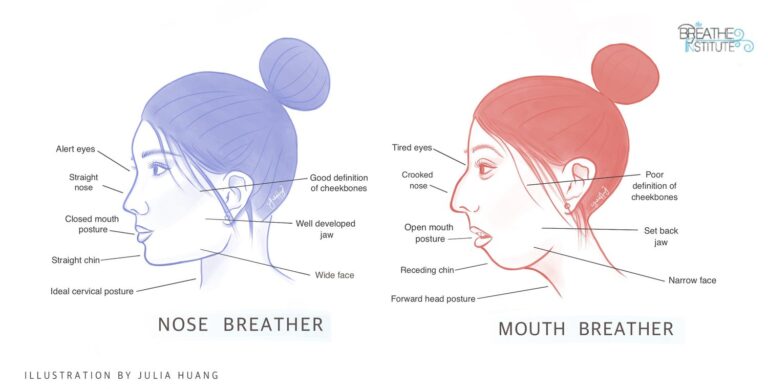Your Swallow, Smile and Sleep are More Related Than You Think!
Your Swallow, Smile and Sleep are More Related Than You Think!

Did you know that with one small intervention you can sleep more deeply, relieve neck, back and jaw pain, improve the symmetry of your face, avoid costly orthodontic interventions, and even heal your brain?
Decades of research into how bodies develop and change have taught us that the way we swallow, a well-formed bite, sleep and even brain health are more interdependent than most of us realize.
We’ve learned that people with well-formed bites also enjoy better vision, better drainage of the ears and sinuses, easier breathing, less spine and jaw pain, and even better sleep; conditions that braces and other costly orthodontic interventions rarely improve and can even worsen in some cases.
We’ve learned that people with well-formed bites also enjoy better vision, better drainage of the ears and sinuses, easier breathing, less spine and jaw pain, and even better sleep; conditions that braces and other costly orthodontic interventions rarely improve and can even worsen in some cases.
How do we optimize balance and function?
Enter . . . the tongue; who knew all that it could do?! A well-trained tongue pushes on the roof of the mouth with about a pound of pressure each time we swallow, one to two thousand times a day. This ongoing action of correct swallowing, coupled with chewing, creates the space needed for a myriad of functions.
How does the tongue learn to do this?
It begins with nursing. Breastfeeding trains the tongue to press just the right way on the roof of the mouth so that its formidable forces and those of other muscles exert in all the right directions. And, it’s never too late to begin or restore healthy function!
What derails the tongue-palate relationship?
Habitual breathing through the mouth due to allergies is perhaps the most common culprit in keeping the tongue from the roof of the mouth, but we can unknowingly create problems through thumb-sucking, pacifiers, most sippy cups, and even common orthodontic devices.
Difficult births, falls and blows to the head are also capable of halting the tongue if they compress the skull bones and the nerves that feed the tongue.
Nutrition plays a fairly large role, as the fat-soluble vitamins A, D, E & K are critical in structural development. Processed foods and refined sugars impair formation of healthy tissues. One difficulty that can arise are tight bands of tissue in the frenums or frenulum (“tongue ties”) that can keep the tongue tied down or the lips from sealing well.
Notably, these challenges to proper facial development are largely features of modern times. Pre-industrial cultures enjoyed far superior facial balance than we do today.
What happens when the tongue doesn’t default to the palate?
When the tongue drops away from the palate (low tongue posture), the needed pumping action on the palate, throat and other soft tissues is missing. Sinuses don’t drain as well and neither do the ears, so congestion is more common. Circulation to and from the brain is also impaired.
In regard to facial symmetry including space for the teeth, the dropped tongue can’t push out against the powerful inward forces of muscles of the cheeks that help us swallow. Unopposed, these muscles can, over time, create a long, narrow face and palates and a crowded bite.
I once saw a 5-year-old healthy breastfed child who had a beautifully formed face and lovely bite. She then got a pet that she was allergic to and spent two years breathing through her mouth. At age 7, she had formed classic dark circles under her eyes, a high and narrow palate, crowded teeth and her chin had receded. She was also having problems with bedwetting, sleep, focus and behavior.
Changes in tongue placement and breathing habits can distort facial structure quickly and the consequences can be drastic.

How does proper tongue function calm the stress response?
A properly functioning tongue has a profound effect on the nervous system. Sleep, the whole digestive process, the immune system, cognitive function and even the ability to access our emotions are supported when our tongue rests in its right place on the roof of our mouths and we breathe through our noses.
Nasal breathing increases intake of both nitrous oxide and carbon dioxide, both of which are calming and support deep sleep. Nasal breathing also delivers more oxygen to the body and brain. All of these effects lower vigilance in the nervous system. This is the rationale for rebreathing our exhaled carbon dioxide from a paper bag during a panic attack.
The fight-or-flight response, which we associate with teeth grinding, bed wetting, nightmares and disruption of sleep, is further lowered when the tongue stimulates the vagus nerve on the soft palate. A healthy vagal response offsets the fight-or-flight response.
This lowering of vigilance resets the body to “healing mode.” I use the mnemonic “Rest, Digest, Heal & Feel” to summarize some of the critical functions that are supported by this coveted and often elusive restorative neurological “setting.”
For kids and grownups alike, nasal breathing greatly supports better sleep mechanically as well. Increased intake of carbon dioxide literally causes the airway to widen. And, less clenching renders the anatomy softer and more easily reshaped.
Additionally, when the tongue is on the palate, it isn’t crowding the airway. Once we are breathing correctly through our noses, we are less likely to snore. Simply training the tongue to rest on the palate can prevent or alleviate sleep apnea, and make it easier for others to sleep near us.
Furthermore, when the tongue is working, many facial muscles tone up, including that waddle of tissue underneath the chin, which happens to be the root of the tongue. Now tell me, who wouldn’t welcome a natural face lift!?
How does tongue function relate to neck and back pain?
If the face doesn’t develop, the airway itself can also fail to widen. This can be seen by simply looking in the throat, or via a proper X-ray or CT scan. And, since breathing is our body’s highest priority, the head, neck and jaw will jut forward and drop down to allow air to pass more easily. This “air-seeking” neck posture wreaks havoc on the jaw and neck muscles, which can ultimately result in many problems including jaw, neck and back pain that won’t easily resolve.
People with airway issues can’t sit straight even if they try. “Air- seeking postures” can distort the entire spine. The head and neck jut forward and cause the torso and pelvis to slump, also causing the front body to tighten and the back-body to lose tone. The legs tend to hyperextend, the back weakens and the buttocks flatten.
Under the influence of these distortions the spine and limbs are tense and less able to move with coordination and efficiency. This is a set up for joint problems and back pain.
To complicate matters, people with narrow airways who also sit a lot have both issues to contend with. What’s more, many “air seekers” prefer to sleep face down because they can breathe more easily this way, but this position is additionally hard on the neck and spine and can compress the brainstem and the vagus nerve at the base of the skull.
It’s interesting to note that in the equestrian world, if after a falling injury, a horse’s tongue is no longer defaulting on its palate, the animal is deemed unable to fully recover.
Do braces help or hinder?
In an ideal world, kids with crowded faces would correct their tongue function early in life to allow correct swallowing and chewing to “grow” the bite and the face so that braces aren’t needed. Most current orthodontics address only the alignment of teeth and do not address facial and body functions. Often appliances themselves create tension in the face that can suppress natural growth in children and complicate facial and spinal remodeling in adults.
So how do we fix it?
To test for mouth breathing, I ask people to try to hold a popsicle stick flat between closed lips for a half hour or so. If this is doable, I have them see if their lips will stay closed even longer with a piece of first aid tape. If the tape is comfortable by day, I have them try to keep it on at night. Nasal breathing will widen the airway over time, so if you only tolerate the tape for a short time, stick with it! Adhesive strips that hold the nasal passages open by lifting the skin on either side of the nose can help.
Sometimes these simple interventions can improve sleep greatly. If the “stick test” is not tolerated we know we have work to do. If sleep improves with taping at night, we know we’re on the right track.
To check tongue function, swallow and note if the tip of the tongue touches the palate, the teeth, or both. Have kids smile and say a word that starts with an “L.” If the tongue does not move correctly, it can usually be seen peeking through any spaces between the teeth. The tongue should not touch the teeth; it should move across the entire palate with each swallow and the tip should ultimately rest about a pinky’s width behind the teeth most of the time.
Mealtime is a great time to train your tongue. Start by sitting in Mountain Pose (yoga’s Tadasana). Imagine your feet and seat moving toward the ground while a cord from the crown of your head moves toward the sky. The shoulder blades “drip” down the back, the chin is tucked toward the chest, and the pelvic floor and core muscles are active but not clenched. All of this helps stabilize the body so the tongue can do the work of swallowing correctly.
Breathing through your nose while you eat will ensure good chewing function. While chewing, forcefully press your food to the roof of the mouth, especially the back of the mouth, until it’s really mush. This can take a while! When swallowing, grimacing can really help engage the right muscles. Remember the important piece of tucking the chin. Place your hand on your lower belly and make sure it stays relaxed, as all the work of chewing and swallowing is done is with the tongue and face!
Basic goals of tongue training include a forceful swallow in which the tongue ripples especially powerfully from the soft palate in the back to the hard palate in the front. We’d love to be able to produce loud sounds when suctioning the tongue to roof of the mouth.
Interestingly, peoples who speak with sucking and clicking sounds enjoy superior facial development.
Music can help
Singing and playing wind instruments can really condition the tissue at the back of the throat. On another note (pun intended!), I have people use their tongues to “beat” their palate along to a song once a day. Janelle Monae’, Grammy nominated song “Make Me Feel” actually uses a suction clicks as percussion! I had been texting the song to folks to help them practice for months before she performed it at the Grammys. I took this as a sign that upbeat songs are great for tongue workouts too . . . after all, science has shown that our brains rewire (in other words we learn) 20+ times faster when we’re having fun!
What if DIY isn’t enough?
Changes, which do come more quickly with kids than with adults, take time. If after many weeks of practice you’re not making gains, consultation with a myofunctional therapist (formerly called orofacial-myologist, tongue trainer or “oral rest posture therapist”) can be very helpful. Some offer consultation by video. These pros can help you train all the muscles of your face and airway to perform the way they are supposed to. They can also help you optimize your airway function and recover from asthma, apnea and other breathing disorders.
If your head was overly compressed at birth or you’ve had falls or accidents, evaluation and treatment by an osteopathic physician skilled in cranial osteopathy can help. These practitioners use their hands to help the body reset its nervous system, soften restrictions in the skull and elsewhere and balance forces from head to toe such that the whole body can “breathe,” align, and support the emergence of a functional swallow and musculoskeletal system.
Complicated cases sometimes benefit from the use of development- friendly dental appliances. These interventions work best when the dentist, osteopath and orofacial-myologist work together.
Hold on to your optimism!
The reality is that with fairly minor and simple corrections, many common health pitfalls, costly orthodontic interventions and even surgeries can be avoided. It’s wonderful and empowering to realize that sometimes a small shift in habits are all the body needs to realize its remarkable ability to heal itself.
— Michelle Veneziano, DO is a doctor of Osteopathic Medicine in Mill Valley, CA
For more information on tongue training visit the International Association of Orofacial Myoolgy (IAOM) and their archive of over 300 related studies.
“Last session, she melted my nervous system and then gently pushed, pulled and twisted my bones into place, including my teeth. My face is more balanced and my teeth are straighter. It’s remarkable.”
~ Carol Sutherland, Life Coach



